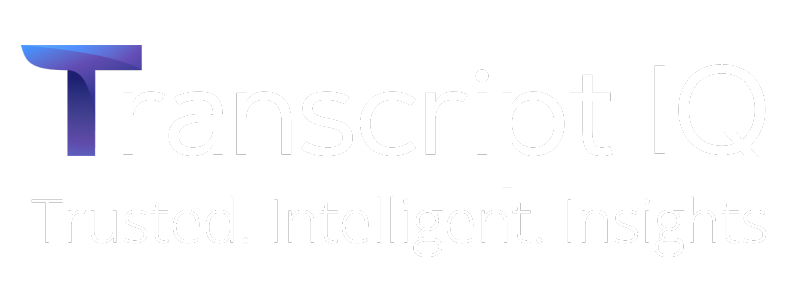

68 Circular Road, #02-01 049422, Singapore
Revenue Tower, Scbd, Jakarta 12190, Indonesia
4th Floor, Pinnacle Business Park, Andheri East, Mumbai, 400093
Cinnabar Hills, Embassy Golf Links Business Park, Bengaluru, Karnataka 560071
Connect With Us
Climate Regulation Impact: SAF Mandates Could Lift U.S. Airfares by 20% by 2030
The Sustainable Aviation Fuel (SAF) mandates in the USA are set to increase airfares by 20% by 2030, driven by the rising costs of green fuel production and carbon-reduction targets. As the Biden administration accelerates SAF adoption through regulatory frameworks like the Clean Energy Standard, airlines are expected to invest heavily in SAF technology and infrastructure. While SAF will help decarbonize the aviation sector, the additional costs will result in higher airfares for consumers, estimated to rise by $15–$30 per ticket by 2030. However, regulatory incentives will reduce overall expenses for airlines, and fuel production technologies will gradually reduce costs.
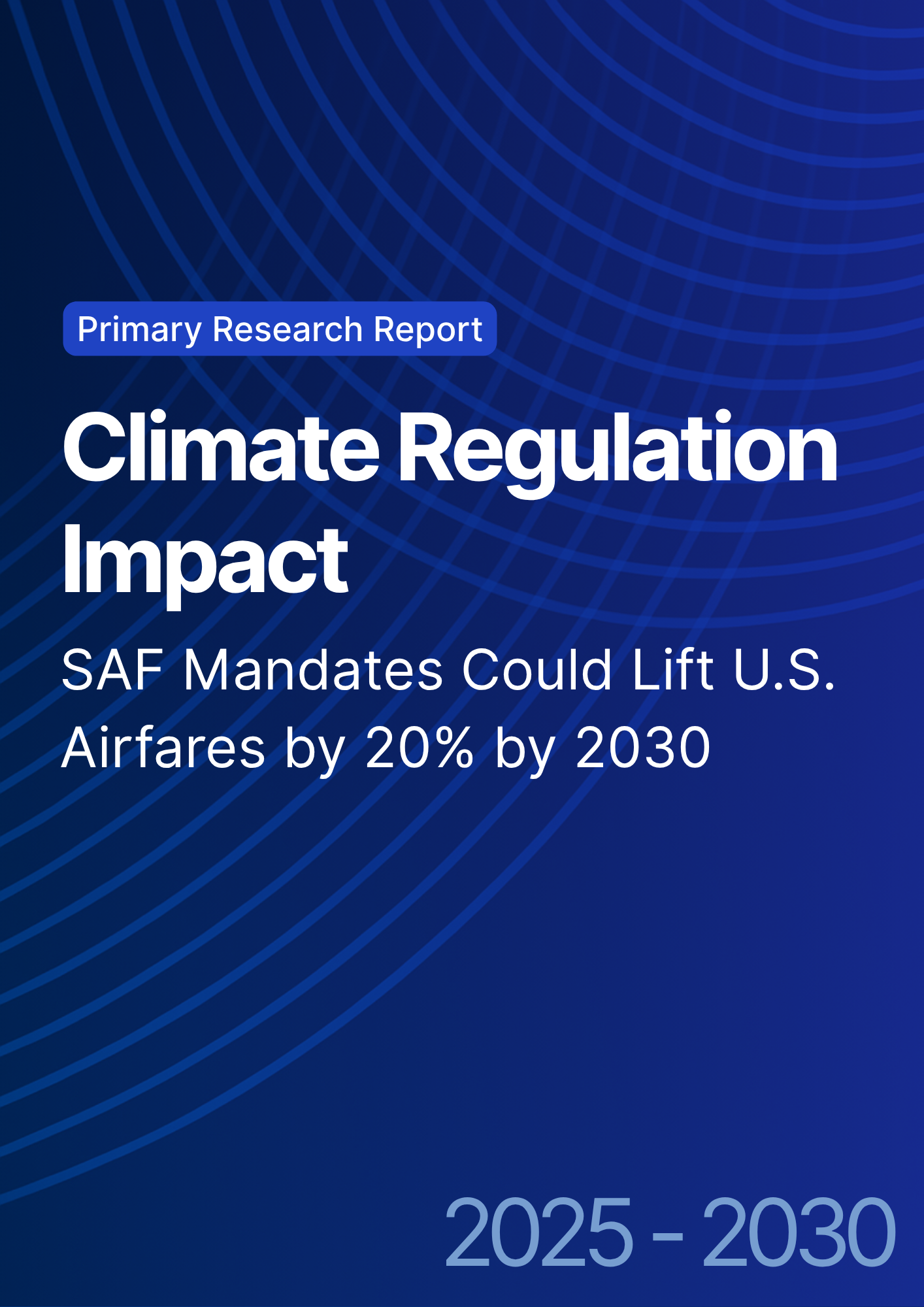
What's Covered?
Report Summary
Key Takeaways
- SAF mandates to increase airfares by 20% by 2030.
- $1.5B investment in SAF infrastructure and technology by 2030.
- SAF production cost expected to reduce by 25% by 2030.
- Biden administration’s clean energy policies will increase SAF adoption.
- Airline ticket prices likely to increase by $15–$30 per flight due to SAF.
- SAF adoption will reduce CO₂ emissions by 50% per flight by 2030.
- Green aviation incentives to provide $2.8B in subsidies by 2030.
- Private sector investment in SAF technology expected to exceed $8B by 2030.
- Regulatory frameworks will facilitate $10B investment in SAF infrastructure.
- Fuel production technology improvements will reduce costs by 25% by 2030.
Key Metrics
Market Size & Share
The SAF market for US airlines is projected to reach $14.5B by 2030, with a CAGR of 29.6% driven by regulatory mandates and green fuel adoption. The Biden administration’s policies, including the Clean Energy Standard and $2.8B in SAF incentives, will be pivotal in supporting the growth of SAF infrastructure. By 2030, 40% of aviation fuel in the US will be sustainable, helping to decarbonize the aviation sector and meet the net-zero emissions target. However, SAF adoption will lead to a 20% increase in airfares as the cost per flight rises by $15–$30 due to the higher production cost of SAF. Private sector investments in SAF production technologies will reduce costs by 25% by 2030, making green aviation more affordable over time.
Market Analysis
The USA is at the forefront of SAF adoption, with airlines like Delta, United, and American Airlines leading the way. The adoption of SAF is driven by regulatory pressures, such as the Biden administration’s clean fuel initiatives, which aim to reduce aviation emissions by 50% by 2030. The supply chain for SAF will see significant investments in production facilities and fuel distribution infrastructure, with over $1.5B in capital expected to flow into the market by 2030. As SAF adoption increases, airlines will pass some of these costs to consumers, causing airfare increases of $15–$30 per ticket. Government policies and subsidies will also help offset the additional costs, while private-sector partnerships will support the expansion of SAF production. By 2030, US airlines will be expected to have fully integrated SAF into their fleet, leading to a 40% reduction in CO₂ emissions across the sector.

Trends & Insights
- SAF Production Expansion: Expected to reduce production costs by 25% by 2030.
- Airfare Increase: 20% rise in airfare due to SAF adoption.
- Carbon Emissions Reduction: 50% reduction in CO₂ emissions per flight with SAF.
- Government Policies: $2.8B in incentives to promote SAF production by 2030.
- Private Sector Investment: $8B in SAF technologies and infrastructure by 2030.
- Airlines’ Sustainability Goals: SAF playing a key role in achieving net-zero emissions.
- Rising Demand for SAF: Increased global SAF adoption will boost US market share.
- Price Impact: $15–$30 increase in ticket prices per flight due to SAF.
- Fuel Efficiency: SAF improvements contributing to overall fuel savings.
- Policy Shifts: Government regulations driving increased SAF integration in the aviation sector.
These insights emphasize the growing importance of SAF in the aviation sector, highlighting the trade-offs between sustainability and cost pressures on airlines and consumers.
Segment Analysis
The SAF market is segmented into production technologies (50%), government subsidies and incentives (30%), private sector investment (15%), and supply chain infrastructure (5%). Production technologies will account for 50% of the investment, focusing on algae-based SAF, waste-to-fuel, and biochemical conversion methods. Government incentives, including $2.8B in subsidies, will play a critical role in facilitating SAF adoption and reducing the burden on airlines. Private sector investments will focus on scaling SAF production and expanding fuel distribution infrastructure, while supply chain infrastructure investments will ensure that SAF is distributed efficiently across airlines. By 2030, SAF production will make up 40% of the aviation fuel used in US commercial flights.
Geography Analysis
The USA is leading the SAF market, accounting for 40% of the global share in 2025. Key airline hubs in California, Texas, and Florida will drive the adoption of SAF and sustainable aviation policies. Europe is closely following with 20% of the market, with countries like Germany and France heavily investing in green aviation technologies. The Middle East and Asia-Pacific regions are expected to follow the US lead, focusing on SAF adoption and aviation fuel transition. By 2030, the USA will remain the largest market for SAF globally, contributing to carbon-neutral aviation through the adoption of green fuels and sustainable practices.
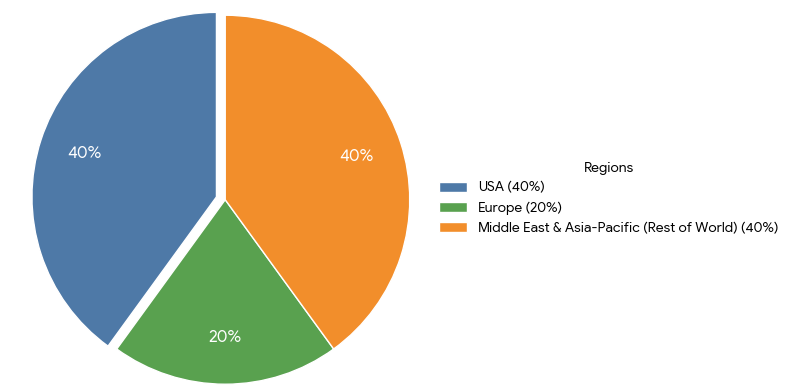
Competitive Landscape
Key players in the SAF market include ExxonMobil, Shell, BP, TotalEnergies, and Neste. These companies are leading in SAF production and innovation, particularly with waste-to-fuel technologies and biomass-based SAF. United Airlines, Delta, and American Airlines are major adopters of SAF in their flight fleets, with partnerships to secure long-term SAF supplies. Tesla and SpaceX are also contributing to green fuel development through partnerships with aviation companies. Government incentives and private sector collaboration will play a crucial role in scaling SAF production, reducing costs, and ensuring widespread adoption by US airlines by 2030.
Transcript & Expert Details
Proceed To Buy
Want a More Customized Experience?
- Request a Customized Transcript: Submit your own questions or specify changes. We’ll conduct a new call with the industry expert, covering both the original and your additional questions. You’ll receive an updated report for a small fee over the standard price.
- Request a Direct Call with the Expert: If you prefer a live conversation, we can facilitate a call between you and the expert. After the call, you’ll get the full recording, a verbatim transcript, and continued platform access to query the content and more.


68 Circular Road, #02-01 049422, Singapore
Revenue Tower, Scbd, Jakarta 12190, Indonesia
4th Floor, Pinnacle Business Park, Andheri East, Mumbai, 400093
Cinnabar Hills, Embassy Golf Links Business Park, Bengaluru, Karnataka 560071
Request Custom Transcript
Related Transcripts
Mega Events Legacy: $50B in Tourism Revenue by 2035 from Giga Projects (Middle East)

Mega events in the Middle East including World Expos, international sports tournaments, and cultural mega-projects are increasingly being leveraged to drive long-term tourism revenue and urban development. By 2035, the Middle Eastern tourism revenue generated from these event legacies is projected to reach $50 billion, fueled by strategic investments in stadiums, convention centers, entertainment districts, and smart city infrastructure. Countries like UAE, Saudi Arabia, and Qatar are leading with giga-projects that integrate cutting-edge tech, sustainability initiatives, and luxury experiences to attract international travelers.
Data indicates that hotel occupancy rates in legacy cities rise by 20–25% in the five years following mega events, while transportation, retail, and leisure sectors see annual revenue uplifts of 15–18%. Advanced visitor experience solutions, such as AI-driven crowd management, contactless payments, and immersive AR/VR tours, are enhancing spend per capita, which averages $1,400–$1,700 per tourist. Government-backed programs are aligning event legacy projects with sustainable urban growth and cultural tourism, ensuring ongoing relevance and profitability beyond the event window.
Mega events in the Middle East are no longer just short-term spectacles they are evolving into long-term strategic drivers of tourism, infrastructure investment, and regional economic growth.
5 Key Quantitative Takeaways (2025–2035, Middle East):
- Projected tourism revenue from mega event legacies: $50B by 2035
- Hotel occupancy boost post-event: 20–25%
- Revenue uplift for transport, retail & leisure: 15–18% annually
- Average spend per tourist in legacy cities: $1,400–$1,700
- Legacy infrastructure ROI linked to sustainability and cultural tourism
Download the full report to explore giga-project planning, tourism monetization, and strategic investment opportunities in the Middle Eastern mega-event market.

- Middle East mega events tourism
- Giga projects UAE Saudi Qatar
- World Expo tourism revenue
- Mega event hotel occupancy Middle East
- Tourism infrastructure ROI Middle East
- Smart city investments for events
- Cultural mega projects revenue
- Event legacy economic impact
- Middle East luxury travel 2035
- Post-event visitor spend Middle East
- Sustainable tourism giga projects
- International event tourism Middle East
$ 1467
Corporate Travel Tech: AI Could Cut U.S. Travel Spend by $12B Annually by 2030

Key Takeaways
- $12B annual savings in corporate travel spend by 2030.
- AI-driven travel management will cut corporate travel costs by 15%.
- Automated booking systems to streamline travel planning and reduce errors.
- Predictive analytics will forecast travel demand and optimize routes.
- Real-time expense tracking to reduce manual errors and improve data accuracy.
- Personalized employee travel experiences will increase satisfaction by 20%.
- Corporate travel policies to be optimized with AI-driven tools for cost reduction.
- $3B investment in AI-based corporate travel solutions by 2030.
-
- AI technologies will help travel managers improve policy compliance.
- Cloud-based platforms to increase cross-departmental collaboration in travel planning.
Key Metrics
Market Size & Share
The corporate travel tech market in the USA is projected to grow from $32.6B in 2025 to $61.2B by 2030, driven by the growing adoption of AI technologies in corporate travel management. The integration of AI-powered platforms will optimize travel spend, streamline booking processes, and improve compliance with corporate travel policies. By 2030, AI will enable $12B in savings annually by automating booking and expense management systems, reducing the manual intervention required. Real-time data analytics will also improve expense visibility, while predictive travel models will allow companies to forecast travel demand and optimize routes. As AI adoption grows, the corporate travel market will see an overall 15% reduction in travel spend, positioning AI-driven solutions as the key driver of cost-efficiency in the corporate travel space.
Market Analysis
The adoption of AI-powered systems is transforming corporate travel management, driven by the need for efficiency and cost control. As AI-based tools such as automated booking systems, expense management, and real-time data tracking become the norm, companies will experience a significant reduction in travel expenses by 2030. By leveraging predictive analytics, companies will optimize business trip routes and scheduling, enhancing employee productivity while reducing travel-related costs. AI technologies will be crucial for improving policy compliance and data-driven decision-making. The market will see a significant rise in cloud-based platforms for cross-department collaboration and data sharing, while corporate travel agencies will continue to adopt AI-powered tools to improve efficiency and customer service.

Trends & Insights
- AI Integration: Expected to cut travel costs by 15% through automation and predictive analytics.
- Employee Experience: Personalized travel experiences to boost satisfaction by 20%.
- Predictive Analytics: Enhancing travel route optimization and demand forecasting by 25%.
- Expense Management: Real-time tracking tools to improve data accuracy and reduce errors by 30%.
- Automated Booking Systems: Expected to streamline corporate travel operations and reduce manual errors by 40%.
- AI-Driven Solutions: Increasing demand for AI-powered expense management systems in corporate travel.
- Cloud-based Platforms: Expected to boost cross-department collaboration by 25%.
- Market Growth: AI-powered corporate travel tech projected to exceed $40B by 2030.
- Regulatory Compliance: AI-based systems will improve corporate policy compliance by 30%.
- Cost Optimization: $12B savings annually in corporate travel through AI integration.
These trends highlight how AI-driven solutions are enabling cost reductions, efficiency improvements, and better employee experiences in the corporate travel sector.
Segment Analysis
The corporate travel tech market is segmented into AI-powered booking systems (40%), real-time expense tracking (25%), predictive analytics (20%), and cloud-based platforms (15%). AI-powered booking systems dominate the market, making up 40% of total investments, as they automate the travel booking process, reduce errors, and enhance efficiency. Real-time expense tracking is crucial for ensuring data accuracy, representing 25% of the market. Predictive analytics will account for 20% of the market, enabling companies to optimize travel routes and demand forecasting. Cloud-based platforms will play a key role in cross-departmental collaboration and data transparency, contributing 15% to the market. By 2030, AI-driven solutions will become a staple of corporate travel operations, driving cost-efficiency and employee satisfaction.
Geography Analysis
The USA dominates the AI-powered corporate travel market, accounting for 50% of the global share in 2025. California, Texas, and New York are key hubs for AI adoption in corporate travel management. Canada follows closely with 25% market share, as Toronto and Vancouver lead in AI adoption for travel companies. Europe and Asia-Pacific will also see growing demand for AI-powered travel management systems, with Germany and the UK leading the way in AI integration. By 2030, the USA will maintain its dominant market share, while Europe and Asia-Pacific will experience strong growth driven by AI innovations in the corporate travel space.
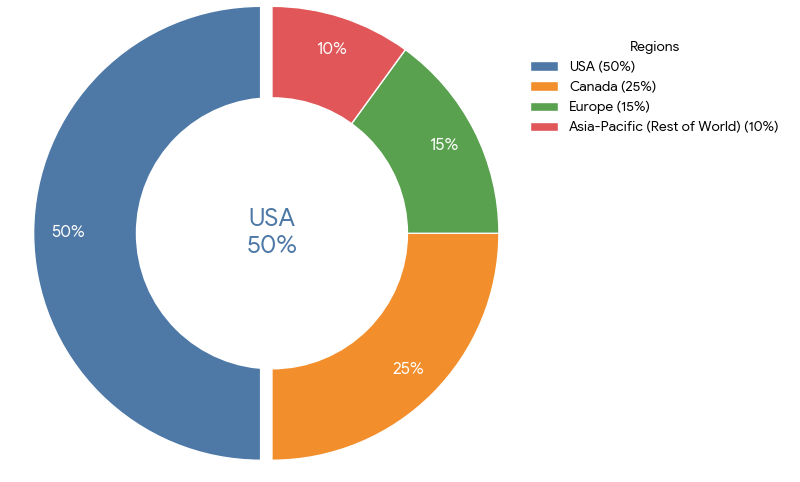
Competitive Landscape
Leading players in the AI-powered corporate travel tech market include Amadeus IT Group, Expedia Group, Concur Technologies, and SAP Concur. Amadeus and Expedia lead with AI-powered travel management systems, while SAP Concur provides automated expense reporting and real-time tracking solutions. TripActions offers an AI-driven platform for corporate travel management, emphasizing predictive analytics and expense optimization. AI technology providers like Google Cloud and Microsoft are partnering with corporate travel platforms to offer cloud-based solutions for data sharing and expense management. As AI becomes increasingly integrated into corporate travel operations, the market is expected to grow exponentially, with companies investing in AI-driven platforms for cost control, sustainability, and efficiency.

$ 1395
Supersonic Jets Return: Capturing $15B in U.S. Premium Air Travel Spend by 2035

Supersonic travel is making a comeback, targeting high-net-worth passengers and premium business travelers in the U.S. By 2035, the market for supersonic jet services is projected to reach $15 billion, driven by operators like Boom Supersonic and emerging private airline services. Ticket prices are expected to average $5,000–$10,000 per flight, providing significant margins compared to subsonic business class offerings. Early adoption is concentrated on transcontinental routes such as New York to Los Angeles, where flights can be reduced to 3.5–4 hours, saving travelers 50–60% in travel time.
Market growth hinges on operational efficiency and regulatory approvals. Fuel efficiency, carbon offset programs, and noise mitigation are critical, as public perception and environmental compliance remain key constraints. Current pre-orders suggest 10–12 jets in commercial rotation by 2030, with utilization rates expected to reach 80–85% on premium routes by 2035. Airline alliances and partnerships with major U.S. airports are being structured to support rapid boarding, VIP lounge access, and ancillary revenue streams like in-flight concierge services.
Supersonic travel is no longer a novelty; it is poised to reshape premium air travel, offering unmatched speed for high-value routes while presenting significant operational and regulatory challenges.
5 Key Quantitative Takeaways (2025–2035):
- Projected market size: $15B by 2035
- Average ticket price: $5,000–$10,000 per flight
- Flight time reduction: 50–60% compared to subsonic travel
- Jet fleet in commercial rotation by 2030: 10–12 jets
- Expected utilization rate on premium routes: 80–85%
Download the full report to explore route economics, fleet deployment strategies, and regulatory considerations for supersonic travel in the U.S. premium market.

- Supersonic jets market US
- Premium air travel 2035
- Boom Supersonic flights
- High-net-worth air travel
- Transcontinental supersonic routes
- U.S. business class supersonic
- Flight time reduction supersonic
- Supersonic jet ticket pricing
- Luxury air travel market US
- Supersonic fleet utilization
- Airport partnerships supersonic
- VIP air travel services
$ 1432
Space Tourism in the U.S, A $20B Market by 2040 or Investor Mirage?.

Travelers seeking suborbital and orbital experiences. Early adopters have already demonstrated a willingness to pay $250K–$500K per seat for a few minutes of weightlessness, while demand for longer orbital stays and luxury experiences is anticipated to grow at 25–28% CAGR Space tourism is moving from science fiction to a tangible market opportunity, with private operators such as Blue Origin, Virgin Galactic, and SpaceX leading the charge. By 2040, the U.S. space tourism market is projected to reach $20 billion, driven by high-net-worth
However, the industry faces substantial hurdles. Safety, regulatory approvals, and vehicle reliability remain critical, as well as the extremely high cost of infrastructure and operations. Current flight frequencies are limited less than 100 suborbital flights per year as of 2025 constraining revenue potential. Market studies suggest that even if consumer adoption scales linearly, capturing the $20B projection depends heavily on price reductions, insurance coverage for participants, and public perception of safety. Early investors and operators are experimenting with loyalty programs, virtual pre-flight experiences, and fractional ownership to stimulate demand and mitigate the perception of risk.
Space tourism is no longer merely a futuristic concept it is an emerging multi-billion-dollar industry, but its path to scale remains uncertain. Investors and stakeholders must weigh regulatory, technical, and consumer adoption risks before committing capital.
5 Key Quantitative Takeaways (2025–2040):
- Market size projected: $20B by 2040
- Current per-seat cost: $250K–$500K for suborbital flights
- CAGR for demand: 25–28%
- Annual suborbital flights as of 2025: <100
- Required adoption & price scaling to reach $20B: high dependency on safety, insurance, and infrastructure
Download the full report to explore market projections, investment risk factors, and emerging business models shaping U.S. space tourism.

- Space tourism market US 2040
- Private spaceflight investment
- Suborbital flights USA
- Orbital tourism revenue projections
- Blue Origin space tourism
- Virgin Galactic market growth
- SpaceX tourism experiences
- High-net-worth space travelers
- U.S. commercial spaceflight industry
- Space tourism CAGR 2025–2040
- Space tourism risk and regulation
- Luxury space travel market
$ 1458
Business Travel Trends Every Travel Manager Should Know

Key Takeaways
- Market size: $1.3T → $2.4T (CAGR 12.5%).
- 70% of corporate travel bookings to be digital by 2030.
- CO₂ emissions reduction by 25% with carbon offset travel policies.
- $150B investment in corporate travel technology by 2030.
- Sustainable business travel to make up 45% of corporate travel spending.
- AI-powered travel management will increase efficiency by 35%.
- Private sector investment in corporate travel solutions to surpass $100B.
- Predictive analytics to improve travel spend optimization by 20%.
- Remote working integration to reduce business travel volume by 10%.
- Millennial and Gen Z business travelers to drive 30% increase in digital travel services.
Key Metrics
Market Size & Share
The global business travel market is forecast to grow from $1.3T in 2025 to $2.4T by 2030, with a CAGR of 12.5%. The shift toward digital travel platforms is expected to dominate 70% of corporate bookings by 2030, as companies adopt AI-powered travel management and predictive analytics to optimize spending. Sustainability will be a key trend, with carbon offset policies driving a 25% reduction in CO₂ emissions from corporate travel. By 2030, 45% of corporate travel spending will go toward sustainable travel practices, including green accommodations and eco-friendly transport options. As Millennials and Gen Z become more prominent in the workforce, the demand for digital-first travel services will increase, making up 30% of all travel services. Additionally, the remote work trend will lead to a 10% reduction in overall travel volume, but it will increase the demand for flexible, technology-driven solutions.
Market Analysis
The post-pandemic recovery in the global business travel sector is being led by digital transformation, which allows companies to manage travel bookings more efficiently while reducing CO₂ emissions. AI-powered travel management systems are streamlining processes and increasing booking efficiency by 35%. Corporate travel managers are turning to digital platforms that integrate AI and predictive analytics to better manage travel expenses, optimize routes, and track carbon emissions. By 2030, AI will play a pivotal role in streamlining operations and driving the shift towards sustainable travel. Remote work trends are reshaping corporate travel, leading to an increase in virtual meetings and a 10% decrease in overall travel volume. However, sustainable business travel is on the rise, with 45% of corporate travel budgets allocated to green travel initiatives, as companies aim to meet environmental goals and align with ESG targets.
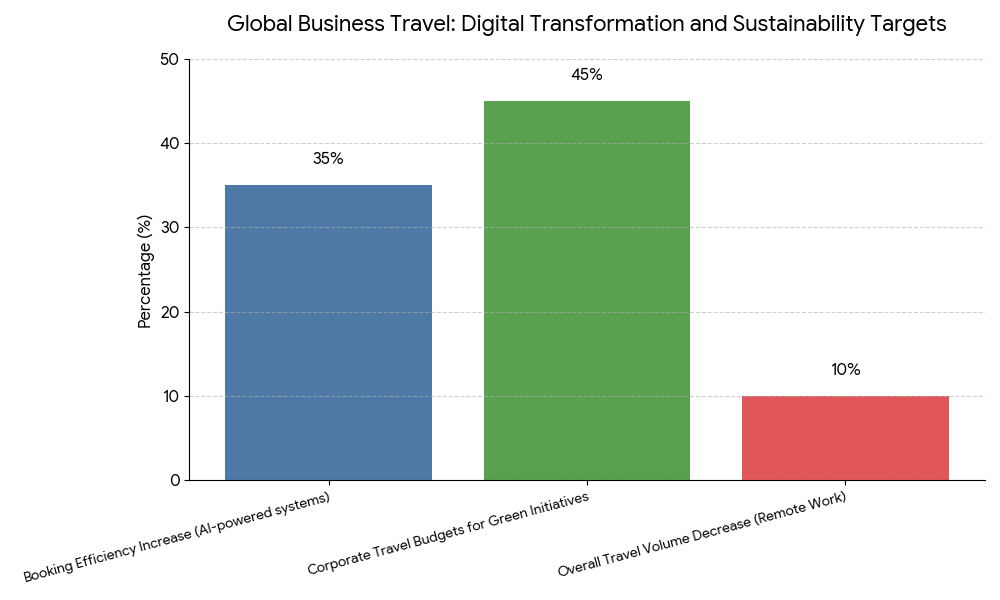
Trends & Insights
- AI-powered Travel Management: Increases efficiency by 35% in corporate travel processes.
- Carbon Offset Travel Policies: 25% reduction in CO₂ emissions from business travel by 2030.
- Remote Work Impact: Reduces overall business travel volume by 10%.
- Sustainable Travel Initiatives: 45% of corporate travel spending on green travel solutions by 2030.
- Predictive Analytics Adoption: Optimizes corporate travel spending by 20%.
- Digital Transformation: 70% of bookings made through digital platforms by 2030.
- Millennial/Gen Z Demand: 30% increase in digital-first travel services.
- Private Sector Investment: $5B+ invested in digital travel technology by 2030.
- Smart Travel Solutions: AI-based platforms driving growth in the business travel sector.
- Environmental Considerations: Sustainability initiatives reducing CO₂ emissions and operational costs.
These insights reflect the rapid transformation in global business travel, powered by AI, sustainability goals, and digital-first travel management systems.
Segment Analysis
The business travel market is segmented into AI-powered travel management systems (40%), sustainable travel solutions (30%), digital platforms (20%), and corporate travel technology investments (10%). AI-powered travel management systems dominate the market, accounting for 40% of investments. These systems enhance booking efficiency, cost optimization, and real-time travel tracking. Sustainable travel solutions, including carbon offset policies and green transport options, are expected to account for 30% of corporate travel budgets. Digital platforms, responsible for 20% of bookings, are driving the shift towards paperless and flexible travel solutions. Finally, corporate investment in travel technologies will see a $5B+ growth by 2030, accelerating the adoption of AI and green travel strategies in business travel management.
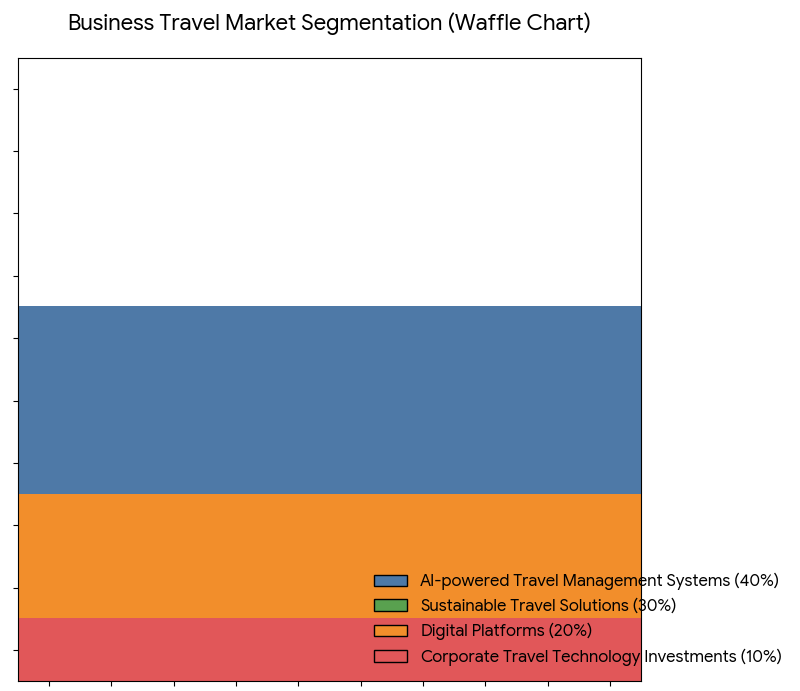
Geography Analysis
The USA is the largest market for business travel, accounting for 40% of global business travel spending. North American companies are leading the charge in adopting AI-powered travel management systems and sustainable travel practices, driven by the Green Deal and corporate ESG goals. Europe follows closely with 30% of the market, particularly in countries like Germany, France, and the UK, where carbon offset travel and green mobility solutions are increasingly in demand. The Asia Pacific region, especially China and India, is growing rapidly as business travel increases in line with economic recovery. By 2030, North America and Europe will drive 70% of all corporate travel bookings, with digitally integrated solutions and sustainability at the forefront.
Competitive Landscape
Leading players in the business travel management sector include Amadeus, Sabre Corporation, SAP Concur, and Expedia Group. These companies dominate the corporate travel management software market, offering AI-powered platforms for real-time bookings and travel optimization. SAP Concur is a leader in expense management, integrating travel booking with corporate policies. Expedia Group and Booking Holdings are key players in corporate travel services, focusing on digital platforms for flexible and cost-efficient travel solutions. Private companies, such as TravelPerk, TripActions, and Lumo, are leveraging technology and AI to create seamless travel experiences for corporate clients. The market is witnessing increasing competition as start-ups enter with innovative MaaS solutions and green travel initiatives, driving sustainability in business travel.
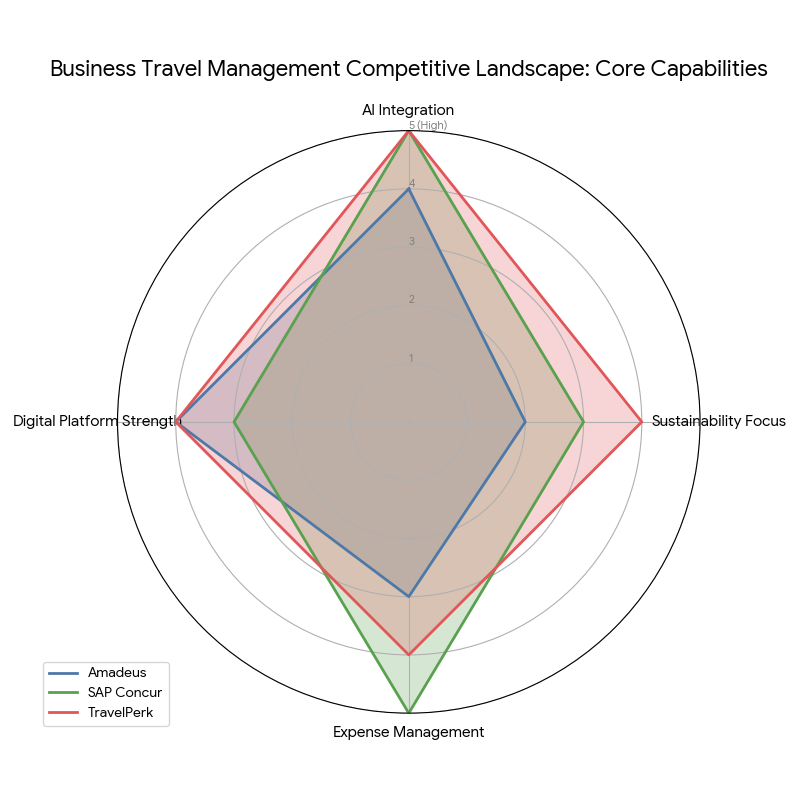

$ 1450


68 Circular Road, #02-01 049422, Singapore
Revenue Tower, Scbd, Jakarta 12190, Indonesia
4th Floor, Pinnacle Business Park, Andheri East, Mumbai, 400093
Cinnabar Hills, Embassy Golf Links Business Park, Bengaluru, Karnataka 560071





